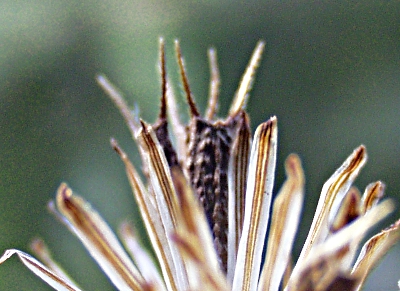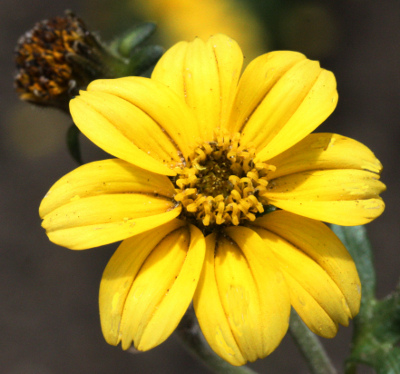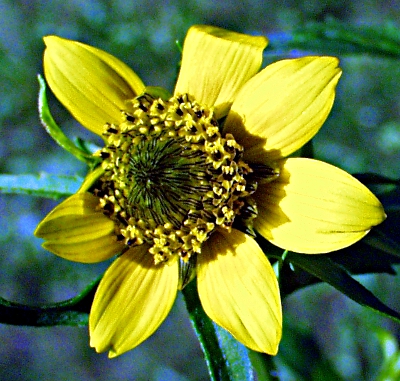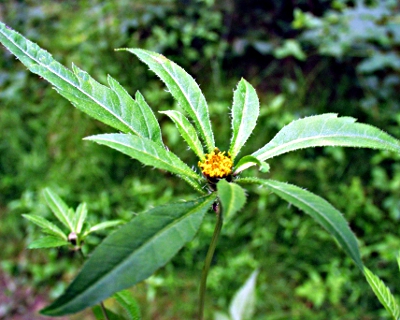Bidens, beggarticks |

The fruits of beggarticks possess tooth-like awns

Bidens ferulifolia hybrids are popular ornamental plants

Radial flower head of the nodding beggarticks

Rayless flower head of the devil's beggarticks
Tournefort described the genus in 1694 in his work Elemens de botanique ou methode pour connoitre les plantes, where he gave the species names a female grammatical gender, although Dens in Latin is male. Linné in 1753 adopted the generic name, including the mistake, in his Species Plantarum. Only recently, the gender of the specific epithet has been corrected.
The number of species of the genus is reported to be over 250. The taxon which is spread throughout the world includes annual or perennial herbs, sporadically occur shrubs or climbers. The stems are mostly upright, often 4-edged, striped or furrowed and branched in the upper part or on the entire length. They usually bear opposite or rarely whorled leaves that are stalked or sessile, in the upper part they are sometimes arranged alternate. The leaf blade is simple or compound, pinnatipartite or lobed, with toothed, serrated or smooth margins.
The radiate or rayless flower heads are yellow, orange, white or pink. They are arranged in racemose or corymbose inflorescences or they are borne singly. The double involucre of the flower heads consists of mostly 5–13 outer phyllaries which are upright, protruding or recurved, herbaceous to leaf-like, and of 8–20 inner phyllaries that are oblong or ovate, membranous or scaly. They form a hemispherical or bell-shaped involucre.
Unless ray florets are present, they are usually arranged in a single row and are neutral or female and sterile and possess 3-dentate to smooth rays that are oval or elongated. The hermaphrodite disc florets have a 3- to 5-dentate corolla, 5 stamens that are connate with the anthers and an inferior ovary consisting of 2 carpels. At the base of the florets are chaffy leaves that are straw-colored, yellow or orange, often striped dark and flat or slightly boat-shaped.
After insect or self-pollination flattened or flat or quadrangular nut fruits (achenes) are formed, that are oblong to elliptic, often with hairy margins, at the top often with 1-5 or up to 8 barbed bristles. They originated from a reformed calyx and serve to spread by animals.
Most Bidens species have tubular and ray florets, but the latter can also be greatly reduced or absent. In turn, species that actually produce only tubular flowers, occasional develop rays. Ray florets make the flower head more attractive to insects, many Bidens species, however, have changed to self-pollination. It almost seems, as if the genus had not yet "completely decided" whether it forms ray florets, that attract the insects or refrained from entirely and goes to self-pollination.
| Floral formula often: |
| ↓ K=awns C(5) A0 G0 and * K=awns [C(5) A5(connate)] G(2) inferior |
Historical publications
Andrea Cesalpino, also called Caesalpinus (1519–1603), reported in his 12th book (De plantis), Chapter 17, after he previously described Eupatorium: „Quaedam in eisdem locis nascitur, ac fere in aquis, brevior Eupatorio, ramosa; foliis eisdem, tripartito diuisis: capitula in cacuminibus fert pauca, stellata flore luteo; semina includuntur valde compressa et oblonga in duos aculeos desinentia: unde Bidens vocetur: colore ex nigro rufescente. Eodem reperitur aliquando folio non dissecto.“
(Another (plant) is growing in the same places, mostly in waters, shorter than Eupatorium, branched; leaves like this, in three parts; head terminal and small, star-shaped flowers yellow, they include strongly flattened and prolonged seeds which have two spines, therefore called Bidens, with dark red color. At this point will be found sometimes also an undivided leaf.)
Useful, medicinal and ornamental plants
Bidens campylothecus, B. amplectens oder B. conjunctus, Hawaiian endemic species, are called by the natives "Koko'olau" and are used as medicinal plants against general fatigue and asthma. After these plants the Koko'olau Crater is named.Bidens pilosus, the blackjack, is used in some parts of Africa as a medicinal and vegetable plant.
Bidens ferulifolius, the fern-leaved beggar ticks, is used as floriferous and strong growing pot- and balcony plant.
Meaning of the species names
- cernuus: lat. cernuus = nodding
- frondosus: lat. frondosus = leafy
Interesting notes
- Some Bidens species, especially those on the Hawaiian Islands, have been reduced the teeth on the achenes in the course of evolution. Probably because there were no land mammals before the arrival of man, which could spread the fruits in their fur.